

The Inyo morning equinox display has been identified as a true animation. The application of metaphor is recognized and interpreted using philosophies long forgotten and in modern times rarely applied properly. This animation reveals the roots of religion previously unknown or disregarded by anthropology, archaeology and ethnography. By content, the location confirms it was destination of pilgrimage.
AN ANALYSIS OF
THE INYO EQUINOX DISPLAYby
Roderick L. SchmidtHistory
The Inyo location has been the subject of several investigations. The commentary by the archaeologists is available in the archaeology section of this web presentation. Their conclusions were guesswork based upon a few literal depictions of "mountain sheep" found at Inyo. Rams, three being obvious, and another four, much less so, became their focus point. With a single independent exception, they argued that Inyo's usage was related to "sheep hunting and sheep hunting magic." Curiously, they ignored the dozen or more sunsymbols present on the site. Eleven are shown below. By their own statistical format, this fact should have directed their conclusions. Inyo should have been declared sun or solar related. Indeed it is.
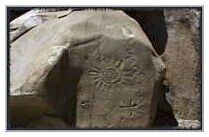

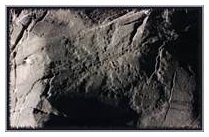
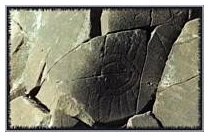
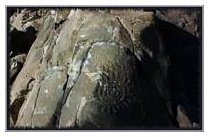
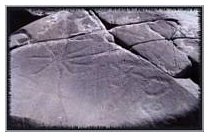

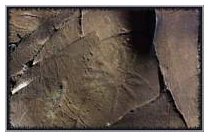
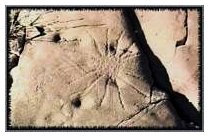
In 1979, Dr. Barry Fell published a book called SAGA AMERICA which claimed that an Inyo inscription, written in ancient Arabic read, "When the Ram and the Sun are in conjunction, then celebrate the New Year." This set off a quite a debate. The purists demanded a retraction because the author of the Inyo text misspelled some words and did not use a classical Kufic alphabet. This argument was simply foolishness.
What Dr. Fell deciphered was a reference to the equinox event. This is now known to be a proper message for the location. What is amazing is that it was confirmed by observation six years later. Despite the misspellings and non-standard alphabet, Dr. Fell read the inscription in question properly. The establishment response to this was to declare it nonsense because history does not acknowledge an Arab presence in the Americas in pre-Columbian times. "History" is political dogma; it is not fact and can not be entertained for scientific analysis as factual. At Inyo there are two identified Arabic inscriptions, by style and content are datable almost thousand years apart. History is in error to deny a pre-Columbian Arabic presence.
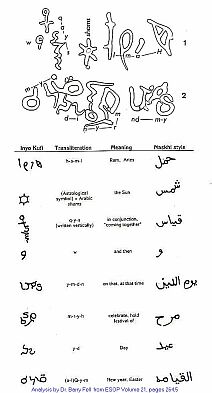
A small, but dedicated group took this message as a clue that there would be some sort of solar marker at Inyo that would identify the day of the "New Year." The actual day was suggested by the inscription to be the vernal equinox. They found one. In fact, they eventually located markers for the entire solar year and two that appear to mark the cross-quarters. Their comments on the discoveries may be found in the Epigraphy section of this presentation. To the left is Dr. Fell's original translation. It is of interest to note that the Arab professors of the University of Tripoli did not question the decipherment. They included it in the Arabic language edition of Saga America which was awarded the Arab Prize for History in 1980.
Now that we are aware of the existence of the Inyo Animation, this notation is particularly appropriate. The status of the location is respected, but any future Arab visitors would be made aware of what to watch for. This was done with apparent cooperation with the Native American hosts who revered the location.
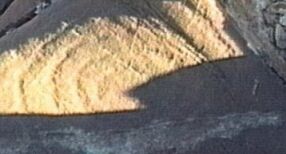
Several years into the investigation (1985) a remarkable discovery was made. Concentrating on what appeared to be a crude set of circles, Mr. Vincent Yoder noticed what he described as a "pointer shadow" that traversed the center circle. His report is available here. Mr. Yoder had suggested this equinox marker be studied further.
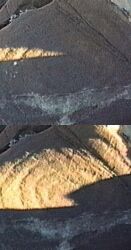
A video study was begun that recorded the event pre, post, and on both the vernal and autumnal equinoxes. It became apparent that the pointer shadow was not the critical element of the event. It did not traverse the measured center of the innermost circle.
However, the darts of light that made up the pointer shadow did appear to deliberately line up with the top and bottom edges of the innermost circle. This looks to have been flattened a bit just for this purpose, thus making it into a stubby oval. Concentrating video efforts on just this portion of the display allowed for a demonstration that proved this interaction was deliberate and remarkably precise. It was intended that this be timed to the true equinox. In the image on the right, do you notice the pecked areas in shadow are difficult to discern? To compensate for that the innermost circle was highlighted, as shown to the left. This allowed for the interaction to be noted with a bit more precision. How these People derived the actual day of the equinox is still under study, but we can demonstrate that they did.
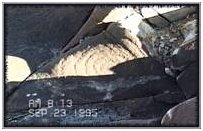


The Complete Story
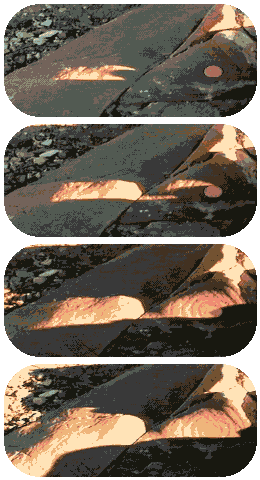
Highlighting the center to achieve a scientific purpose had an unexpected benefit. It allowed the intended story to become clearly explainable. The interaction that took place in the center of the inscribed area was a small portion of the intended display. The image of a snake, made from sunlight, emerges from the stone. This begins shortly after the sun rises. It is still very low on the horizon. The snake has open jaws as if ready to eat or attack something. This serpent is then challenged to cross a fracture in the boulder. This feature is an impediment to its travels, but it overcomes this as the sun rises. It is in slow but constant motion. The serpent continues directly to the innermost circle and begins to "eat" it. During this portion of the display, the serpent starts to expand as if to join the illuminated portions of the site. Once the center is consumed, the serpent merges with the sunlight that has now almost totally enveloped the site. Time from start to finish is about an hour. It is a natural heliolithic visual metaphor enhanced by the hand of man.
The Native American Connection
A search for iconographic material from Native American resources revealed the serpent or snake and egg motif very common and in a variety of forms. The largest being the serpent mound in Ohio.
There are many theories concerning this object. The date of construction is guessed to be anywhere 1000 BC to 1000 AD give or take a century. What we discern as an egg for this discussion has been called anything from an egg (the obvious assumption) to a frog. What we have learned from Inyo applies. We know what the serpent is supposed to do with the egg and equally important, when. Whether the Serpent Mound has a specific equinox alignment or accompanies some time revealing device is an unknown. Now it is arguable that the story it demonstrates is equal to the story told at Inyo. The only difference is that the mound is a static display.
The impression that this is a unique example is false. Numerous serpent effigies of Native American construct exist and have been noted. Constructs vary in size, shape and construction, but the theme is obvious. Medicine Butte, Wisconsin; Kentucky Serpent Mounds, Morgan and Lawrence counties, Kentucky; South Dakota Serpent Mounds, "The Blood Run Site" (now destroyed); Serpent Mound, Hughes County, South Dakota; Georgia Serpent Mound; West Virginia Serpent Mound, Logan County, West Virginia; Serpent Mounds Park, Ontario, Canada; are all serpent effigies. Few have been explored for astronomical evaluation.
In Native American "Rock Art," a very common noted symbol is the snake and sun or egg. Little is available for general research concerning the image of the serpent and Native theologies. The frequency of the design in the petroglyph record has been noted, but no one was able to place a significant definition to the symbolism. The establishment books on the subject of petroglyphs note the existence of the serpent or snake, but fail to categorize it as anything other than representative of the animal.
In the "Field Guide to ROCK ART SYMBOLS Of the Greater Southwest", Alex Patterson writes of snake designs being called "lightning snakes" by a tribal elder. One has to wonder how this name came to be and if the translation to English did not loose something in the process. It would not take much to make this into the Serpent of Light, or as this equates, The Serpent of Wisdom. Heizer and Baumhoff's 1962 work on rock art notes the existence of large numbers of images of snakes or serpents, but makes no analysis as to meaning.
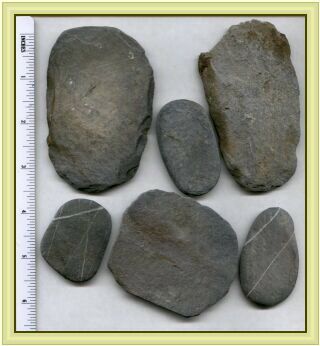
These are a few Inyo artifacts. They have been identified as objects used in ceremonial dances. They are totemic representations of eggs, the fruit of a sky animal. This translation comes from the Shoshone language. However, the concept of "fruit of a sky animal" applies regardless of language. The Shoshone are inhabitants of the area for about the past 1,000 years. Inyo was already old before they arrived. Three of the items shown are made from slate, the other three are thin beach cobbles. These artifacts were under water until the Owens Lake dried up to reveal the prehistoric ceremonial locations. These are but a few of the hundreds of examples observed on the playa. In the book that led researchers to the Inyo site in the first place, Saga America, Barry Fell noted something quite similar. He recognized elements of the Garden of Eden myth where Native Americans performed a ritual dance with "circular objects." One image comes from Iceland (A) the rest from a report by E. B. Renaud from Colorado. Argument can be made for the artifacts shown above are what are depicted in the Colorado petroglyphs.
Old World Connection, 1
One facet of this research project has revealed the image, an appropriate prayer to this image written in the proper language and alphabet in relation to the image and a huge petromantic message that literally read, relates to the image. Three different items refer to Lugh. Two of them in the Celtic writing system called Ogam. References sought, Lugh was revealed to be a Celtic "God of Light." The dynamics of Stonehenge have demonstrated it to have been a Celtic construction, despite argument otherwise. Migrations, transitions and invasions have left little or no historic record. Though some may exist, they are treated as mythology. However, the grave goods from a nearby cemetery dated to the early building stages of Stonehenge demonstrate an early form of Ogam (Celtic) that revealed a prayer to Byanu (Celtic Earth Mother). History has Stonehenge being used for "Druidic (Celtic) Rituals" with few other details being recorded.
Near Stonehenge is Avbury, huge in comparison and a thousand years older.
William Stukley drew this representation in the mid-1700's and called Avbury, "A great Druid temple" (Celtic). The "avenues" that made up the body of the serpent were three miles long. Like Stonehenge, Avebury has a specific alignment to the summer solstice. Harold Bayley in "The Lost Language of Symbolism" chapter called "The Stone Hinge" suggested Stukley's rendition to be that of a serpent having consumed an egg. Bayley went on to explain the ancients use of circles and application of the words light, fire, wisdom and enlightenment.
Some may argue that Stonehenge is not Celtic. This defies the evidence. Roman historians had no problems assigning Stonehenge to the Celts. The issue is resolved however in the grave goods of its constructors. Dr. Barry Fell presents us with evidence that demonstrates the use of an early form of Ogam, the Celtic writing system, recovered from a burial that dated to the early stages of the construction of Stonehenge.
There appear to be no records of serpent and egg mythology in Celtic literature. Now that we know the rationale of the applied mythology, this should be expected. The fanatic Christian factions existent after 328 AD had little tolerance for so-called Pagans and exterminated them with both zeal and contempt. Some strategic sacred sites were converted for Christian use, all others destroyed. All mythology that survived to be recorded was under the control of an agency that by habit and convention, eradicated elements that could be seen as a "work of the devil." (Read that to mean "representative of opposing theologies.") This eventually extended to Avebury. All but a few stones were removed or destroyed. But, because of its sheer size, enough survived for Stukeley to make a certain identification of a serpent and egg design. Serpents have a unique position in Christian mythology, they are never mentioned with favor.
The Celts, whether from North Africa, Iberia or other points unknown are not credited by history for reaching the Americas well prior to Columbus. This makes for a problem, because the evidence says they did.
Old World Connection, 2
It might surprise you that the same symbolism demonstrated by the Inyo animation has survived into modern times. The serpent and egg design is actually very common in modern usage and public display. There is little regard given to exactly what this symbolism represents. It has been adopted because of its historic Greek roots by a people who had lost all knowledge of the dynamics present in the representations. Perhaps the Inyo animation will enlighten them.
The insignia, or totem if you prefer, of the ancient healers was the tree of life, drawn as a rod or staff with the egg of renewal (sun symbol) perched atop to be consumed by a serpent or pair of serpents. This symbol was adopted by the Greek healers and resurrected to serve as the emblem of the modern medical establishment, the doctors' caduceus. Apparently, the healers and astronomers were originally of the same religious group. The Encyclopedia Britannica states the caduceus was the insignia of Hermes. This simplistic notation tends to conceal the older Earth Mother roots. In some of the examples, the egg is understood. Britannica also suggests the rod is representative of a druid's wand or staff. This was an object made from a tree and retains the attributes required. Again, we can identify the symbolism as a static rendering of the story presented at Inyo. What becomes clear is that the emblem is not one of medicine as it is touted, but an identifier of religious belief.
Old World Connection, 3
With not so subtle reinterpretations and/or modifications of text and a very different conclusion, the serpent and egg story begins the Christian Bible. A document of indesputable Old World origin. Below are illustrations of the story.
Five of the six illustrations have the Serpent shown with human attributes. This is similar to the Native American depictions from Colorado. In all cases, this has a practical effect giving the Serpent the ability to communicate. In the Biblical illustrations the fruit has been transformed from egg to apple. This has a logical effect. The Serpent can no longer be considered the intended receiver of the fruit. It is a simple fact that snakes do not eat apples. They do, however, eat eggs.
The Inyo Animation The conclusion of the modern version has been modified to have a particular psychodynamic effect to the intended youthful listener to this tale. That is that he (or she) lives in a place other than Paradise or Eden and must accept this as fact. The Inyo conclusion reveals another ending entirely. It becomes obvious that the Serpent is the intended receiver for the fruit (of a sky animal). The serpent is satisfied, thus mankind, the People, may live in Paradise or Eden. Powerful lessons to learn as a child.
Applied Mythology
Joseph Campbell, the mythologist and Harold Bayley, author of The Lost Language of Symbolism independently concluded there is a global root of ancient mythologies. There certainly is. Examining the elements of the Inyo Animation with the collective mythologies enables one to understand the significance.
Sky Animals

Superstition played a big part in the lives of the People. In some ways, it does today. What child can avoid stories about storks and babies? Or hear that Owls are wise? What child argues for realism?
One must recognize the simple fact that to the ancients, these were nothing more than following traditional directives with religious roots. Some superstitions were natural observations and divined conclusions. Simple fact, birds fly. Some glide with ethereal majesty, others flap. Regardless, the ability to fly was divined by all as a clear demonstration that they shared the favor and had direct communication with the Sky Father.
In Native Nation tradition, the thunderbird is a fair example of the reverence for avian life forms. So is the habit of adornment of feathers. What is lacking in the modern conceptions is the fact that the feathers were not solely decorative, but religious and intended to invoke the powers and spirit of animals favored by the creator.
We explain "flight" as laminar flow above and below a curved surface. These create areas of high and low pressure. This results in an ability to generate lift when in proper motion. The ancients explained the same process as a gift from the creator. Our explanation is based on scientific postulates. The older explanation was religious. This ability to fly was interpreted as an ability to join with and commune with the Sky Father. This is the reason for the existence of such mythical animals as winged sphinxes, griffons, angels,
harpies, Pegasus, dragons, etc. All are earth animals (or people) given the "magical" ability to commune with the Sky Father. Birds and flight had major religious importance. With this in mind, the brilliant translation of the Phaistos Disk by Dr. Barry Fell makes perfect sense. It revealed a standard set of instructions for divining based upon the behavior of birds.
Eggs had several distinctions that placed them in a very special category. Their shape for one. They could be rotated to appear as a perfect circle. This was revered symbolism, the ultimate Sky Father symbol, the sun. The fact that these came from birds who held the favor of the Sky Father naturally reinforced the concepts.
Serpents
The fascination with snakes or serpents as icons of the Earth Mother has its roots in natural observation. This creature has no
legs and spends its time in full contact with the Earth Mother. The feature was divined to mean that the species had her favor. With this favor came its ability to commune with her. The southwest Native Americans were noted for their "Snake dances," but it appears no anthropologists have made the connection that this was a dance to incur the favor of the Earth Mother. "Rain dances," on the other hand, were probably intended to invoke the favors of the Sky Father. These were not simply dances, but religious ceremonies.
The fact that snakes often were seen coiled and sunning themselves was probably the reason the spiral or coil is an Earth Mother symbol. This has global and not simply regional applications.
It is a four-ringed spiral that surrounds the egg at Inyo. This feature was unknown until recently. A rubbing made it clear what had been previously described as crude circles, was in fact a spiral with four loops. The number four has numerical significance. It is a solar indicator. If it had nineteen rings, it would probably have a lunar connection, like the solar device at Fajada Butte, Chaco Canyon, New Mexico.
Petroglyph was NOT chalked
for this demonstration.
Image is link to
www.solsticeproject.orgFajada Butte is a close relative to Inyo. The location is home to an extraordinary collection of heliolithic displays that include a snake (serpent) and spirals, both singular and connected. It appears that Inyo may be older by a thousand years or more.
Light and Fire
Fire was the result of lightning. Lightning came from the heavens and was an act of the Creator. In the earliest scheme of life, fire was considered a gift from the Creator. Tool making and fire making go hand in hand. Striking one stone upon another, as the flaking process requires, occasionally creates sparks of super heated stone; miniature lightning. How many years ago this was discovered and utilized is an unknown, but a guesstimate of several hundred thousand years is reasonable. The transference of this concept and knowledge was global.
Ancient references to light, lightning, or fire are actually metaphor for being educated or having the ability to make fire simultaneous to having the favor of the Creator to enable this ability. Modern phrases like "the eternal flame" result from the original pledge to maintain the belief structure of the People. Having achieved enlightenment is another example. Flames and light were sacred.
The ability to communicate these philosophies was also dealt with in metaphor. Being able to "breathe fire", "speak with thunder" or an object that exhibited unique qualities of light, fire, thunder or flame should be assessed as being gifted by the Creator with an ability to impart wisdom or enlightenment. This concept is applicable at Inyo in two different instances. The equinox animation serpent is created from direct sunlight and the description of Lugh from historic sources declare him to be a "God of Light." There are numerous such descriptions in religious texts of documentable ancient origin. In modern times, the knowledge of the religious beliefs, true source for metaphoric reference, has been culled from standardized references. This lack of common reference has led to attempts at understanding the meanings of surviving texts and instructions by literalization. The results have been gibberish. When the appropriate reference is known and applied, the meanings of many ancient texts and legends may now be reconsidered and dealt with properly.
Science, or lack thereof
Mindset of the Ancients
The People who created Inyo were highly skilled. Their knowledge of solar movements has been previously uncredited. No archaeology of the Owens Valley recognizes this capability among the Shoshone and/or Paiute people of historic or prehistoric venue. Yet, Inyo is mute testimony that someone or some group was present and had this ability.
Archaeologists and some historians suggest that they were relative newcomers to the Owens Valley and their migration began between 800 to 1,000 years before present. For the sake of simplicity, about 1000 AD. However, we can demonstrate that Inyo was being used a thousand years before this. Who were these earlier People, the creators of Inyo?
A thousand years ago, literally thousands of people congregated on the playa for a huge equinox celebration. At any such gathering, trade of material goods and information was part of the process. There is no reason not to believe what changed 800 to 1,000 before present was the introduction of pottery to the existent People. What migrated was the technology, not the People.
Several things can be gleaned from Inyo and its style of execution. Whoever these People were, they had among them someone knowledgeable enough to calculate the equinox, the cross-quarters and both solstices. Some evidence suggests this was based on reading a graduated gnomon. The site has numerous standing stones which could and possibly did have this function. How we read their specific notation and interpret it properly will take more time. At least we have some clues as to what to look for.
This analysis may seem devoid of what is called "hard science." We did not measure to an accuracy of 12 digits. Once we recognized the significance of the Inyo animation, "hard science" became unnecessary. Not that this aspect has been ignored. It is simply, the ancients did not have such measuring devices as we have now. Demanding that they comply with modern measurements did not seem reasonable. There are far more important issues. Myth comparisons to known examples whose roots are lost in history logiclly reveals the Inyo Animation as those very same "lost" roots. The parallels are obvious. "Hard science" tends to confuse this issue. Epigraphy, on the other hand, lends clarity.
Barry Fell shattered the myths of history. James Burke demonstrated some unique "Connections" that show how a small but powerful elite can control a society. Joseph Campbell showed us that mythology is a method to obtain social control of reactive behavior. Harold Bayley has suggested that the origins of spoken language has deeply religious roots. Inyo has shown us just what those long forgotten and suppressed roots are. Validated, no longer a mythology, but a fact, carved upon the very bedrock.
Epigraphy is understanding ancient inscriptions. Some are not in any language, but pure symbolism. Fortunately, the global usage of this symbolism has left clues to aid in determining its meanings. I am thankful to have been introduced to the writings of Harold Bayley. His "Lost Language of Symbolism" is a treasure trove of mystic symbolisms and roots thereof.
The ancients were quite accurate in determining the day of the equinox. By observation and measurement, they constructed the solar year. This was done to match an existent global calendar system. The year was divided between the solstices at the midpoint. Not the daycount midpoint, but physical, based on position midpoint; the equinoxes.
There are sufficient details at Inyo to account for solar notation. If and how these may have been used is subject to observation and confirmation. You may assist in this process by contributing to the project. We suspect the notational devices will demonstrate the on location calculations for determining the equinoxes and cross quarters. These appear to have been determined by solar position in the sky at noon and not at the horizon.

Noon marker |
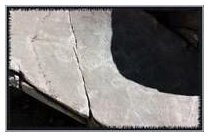
Noon marker |

Calculation Grid |

Lunar Notation |
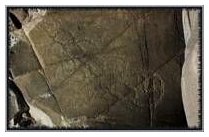
Noon marker |

Calculation Grid |
The choice of the equinox to start a "New Year" is curious. It is neither a beginning nor end, it is a midpoint. Why choose the midpoint to key the year, rather than the more obvious and easier to measure solstices? Once you understand the antiquity of this measurement system, the answer becomes obvious. They had been at this for so long, they noticed the solstices were moving. This is a factor known to science as precession. Inyo has details that may be affected by this factor. The necessity for a standard was solved by adopting the midpoint. No matter where the solstices ended up, this would be a measurable constant.
A modern myth concerning the equinox came about with the decipherment of Egyption picture writing. "The day of balance," the Egyption term for the equinox, was assumed to relate to an equal portion of day and night. It was usually depicted with an image of a balance, a scale used for measurement. What is clear now is that the Egyptians used metaphor in their depictions. Actually, the idea of balance between day and night is a popular but silly assumption. The ancients, despite their skills, did not have stopwatches. There was no way they could have accurately determined equality between night and day. This effect is transitional and subject to positional variance. So what balanced? The equation they had for solar position. The sun was halfway between solstices, the midpoint constant, the equinox.
The Endangerment
Inyo is a tremendous resource. Sadly, it has been severely mistreated in the recent past. The area was leased as a quarry and an unknown portion of the location was eradicated forever, crushed to roadfill. The contractor was totally unconcerned that his actions were so historically destructive. Some clues to what was lost come from the 1929 Steward survey and the 1931 Baldwin survey. About 30% of their recorded images cannot be found today.

Blasting Damage |
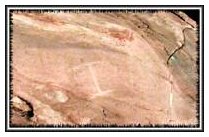
Scratched Initials |
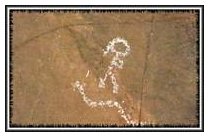
Pecked addition |
What exists today is under constant threat from casual destruction by people ignorant of its significance.

Blasting Damage |
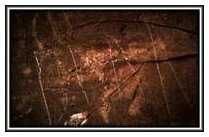
Scratched Message |
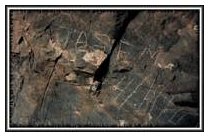
Scratched Name and date |
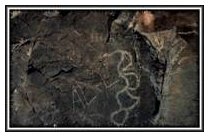
Scratched Name |

Bullet Damage,
|
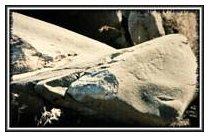
Blasting Damage |
There is much to learn. You may contribute to aid the project and learn along with us. Our goals are preservation and understanding.
© 2008The Equinox Project, All Rights Reserved. Compiled from the
contents of The Dawson Library
Created for and maintained by The Equinox Project Please email any comments, questions or suggestions to:
info4u@equinox-project.com
NOTE you must remove !!! from the suplied address before using.
Last Modified January 2010